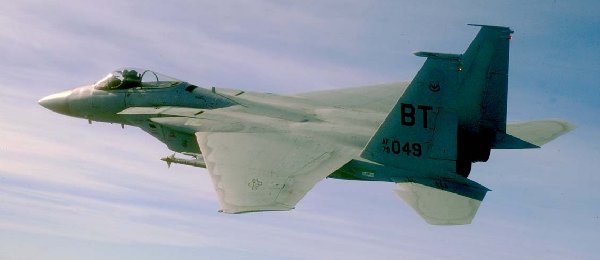McDonnell Douglas F-15 Eagle
Data for C variant

Photo from USAF Homepage F-15C Eagle

The McDonnell Douglas F-15 Eagle is arguably the best air superiority fighter in the world today. The Eagle incorporates two powerful F100 turbofan engines with a strong airframe, potent armament, excellent maneuverability, and advanced avionics. The F-15 was designed for two principal reasons. One, the development of the MiG-25 "Foxbat" in Russia, and the lack of a fighter capable of fighting other fighters. The second point was emphasized in Vietnam by the agile MiGs used by the North Vietnamese. Until the F-15 program the USAF had built to separate types of fighters. Interceptors designed to shoot down bombers, but lacking the maneuverability to engage fighters; and fighter-bombers capable of high speed and carrying a heavy payload, but again lacking the maneuverability to engage enemy fighters effectively. The USAF issued a specification for an air superiority fighter, designed to fight enemy fighters. The F-15 unlike the F-4 Phantom or F-105 Thunderchief did not sacrifice air-to-air performance for the ability to carry bombs. Thus, the F-15 emerged in 1972 it was, and is the best air superiority fighter in the world. In 1979 the F-15A's and B's ceased production and were replaced by the upgraded C and D models. The F-15 kept the same missile compliment as its predecessor the F-4, however, with the development of the AMRAAM the F-15 also surpasses the F-4 in missile capability. Eagles now serve not only the US, but Saudi Arabia, Japan, and Israel. Considering the Eagle is an expensive aircraft its foreign success is testament to its incredible performance. That performance is truly incredible, 96.5 kills and no Eagles lost. In fact the second ever Eagle kill was a Syrian MiG-25, the very plane the Eagle was built to combat. The development of the highly successful F-15E Strike Eagle fighter-bomber is somewhat ironic because of the original specification for a fighter and nothing but. It is unlikely the F-15 fighter variants will remain in production after the new Boeing F-22 Lightining II comes online, however, F-15's will remain in service for some time to come, continually being upgraded. The Strike Eagle will remain in production and provide the USAF with an advanced fighter-bomber throughout the early 21st century.

Specifications
(Data for F-15C)
Origin: McDonnell Douglas Corporation
Type: Tactical/Air Superiority Fighter
Crew: 1
Powerplant: Two Pratt & Whitney F100-PW-100 afterburning turbofans each delivering 11 250 kg (25 000 lbs)
Dimensions
Span: 13.06 m (42' 10")
Height: 5.69 m (18' 8")
Length: 19.43 m (63' 9")
Weight: (Max takeoff) 30 600 kg (68 000 lbs)
Performance
Maximum Speed: 3 000 kph (1 875 mph) at sea level
Cruising Speed: 917 kph (570 mph)
Climb Rate: 15 239 m (50 000 feet) /min
Range: 5 520 km (3 450 miles) ferry range with conformal fuel tanks & three external fuel tanks
Service Ceiling: 65,000 feet (19,697 meters)
Armament
1x M61A1 20mm mulit-barrell canon with 940 rounds ammunition & 4x AIM-7F/M Sparrow or AIM-120 AMRAAM air to air missiles under fuselage & 4x AIM-9L/M/X Sidewinder or AMRAAM air to air missiles on wing pylons.
First Flight: (A) 27 July, 1972
User(s): US, Isreal, Japan, Saudi Arabia
Production: 1 300+ (all variants)
Unit Cost: 15 million $US

Go to previous aircraft 
 Go to next aircraft
Go to next aircraft

This page hosted by  Get your own Free Home Page
Get your own Free Home Page
 Return to Homepage
Return to Homepage Return to Fighter Command
Return to Fighter Command The Aerodrome's Glossary of Aviation Terminology
The Aerodrome's Glossary of Aviation Terminology